
A world's fair or world fair is a large international exhibition designed to showcase achievements of nations. These exhibitions vary in character and are held in different parts of the world at a specific site for a period of time, ranging usually from three to six months.

Olomouc is a city in Moravia, in the east of the Czech Republic. Located on the Morava River, the city is the ecclesiastical metropolis and was a historical capital city of Moravia, before having been sacked by the Swedish army during the Thirty Years' War. Today, it is the administrative centre of the Olomouc Region and the sixth largest city in the Czech Republic. The city has about 100,000 residents, and its larger urban zone has a population of about 480,000 people.

The Exposition Universelle of 1900, better known in English as the 1900 Paris Exposition, was a world's fair held in Paris, France, from 14 April to 12 November 1900, to celebrate the achievements of the past century and to accelerate development into the next. The fair, visited by nearly 50 million, displayed many technological innovations, including the Grande Roue de Paris Ferris wheel, the moving sidewalk, diesel engines, talking films, escalators, and the telegraphone. It also brought international attention to the Art Nouveau style. Additionally, it showcased France as a major colonial power through numerous pavilions built on the hill of the Trocadero Palace. Major structures remaining from the Exposition include the Grand Palais, the Petit Palais, the Pont Alexandre III, the Gare d'Orsay railroad station and two original entrances of Paris Métro stations by Hector Guimard.
The year 1891 in architecture involved some significant architectural events and new buildings.
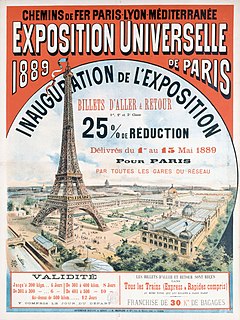
The Exposition Universelle of 1889 was a world's fair held in Paris, France, from 6 May to 31 October 1889. It was the fourth of eight expositions held in the city between 1855 and 1937. It attracted more than thirty-two million visitors. The most famous structure created for the Exposition, and still remaining, is the Eiffel Tower.

Visegrád is a small castle town in Pest County, Hungary. It is north of Budapest on the right bank of the Danube in the Danube Bend. It had a population of 1,864 in 2010. Visegrád is famous for the remains of the Early Renaissance summer palace of King Matthias Corvinus of Hungary and the medieval citadel.

The 1873 Vienna World's Fair was the large world exposition that was held in 1873 in the Austria-Hungarian capital Vienna. Its motto was "Culture and Education".
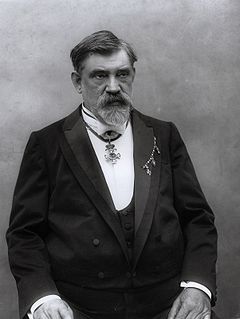
František Křižík was a Czech inventor, electrical engineer, and entrepreneur.

Empire Exhibition, Scotland 1938 was an international exposition held at Bellahouston Park in Glasgow, from May to December 1938.
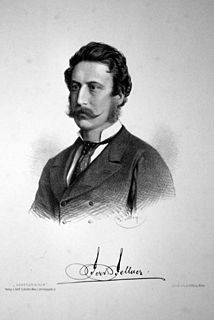
Fellner & Helmer was an architecture studio founded in 1873 by Austrian architects Ferdinand Fellner and Hermann Helmer.
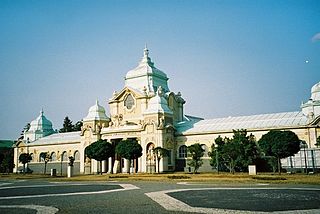
The Lapidarium is a lapidarium and a part of the National Museum in Prague, Czech Republic. It is the largest permanent exhibition of historical collections of stone sculpture, tombs and architectonical fragments originating from Bohemia, mostly from Prague.

The 1929 Barcelona International Exposition was the second World Fair to be held in Barcelona, the first one being in 1888. It took place from 20 May 1929 to 15 January 1930 in Barcelona, Spain. It was held on Montjuïc, the hill overlooking the harbor, southwest of the city center, and covered an area of 118 hectares at an estimated cost of 130 million pesetas. Twenty European nations participated in the fair, including Germany, Britain, Belgium, Denmark, France, Hungary, Italy, Norway, Romania and Switzerland. In addition, private organizations from the United States and Japan participated. Hispanic American countries as well as Brazil, Portugal and the United States were represented in the Ibero-American section in Sevilla.

The Turin International was a world's fair held in Turin in 1911 titled Esposizione internazionale dell'industria e del lavoro. It received 7,409,145 visits and covered 247 acres.

The Glasgow International Exhibition was the second of 4 international exhibitions held in Glasgow, Scotland during the late 19th and early 20th centuries.

Výstaviště in Prague is an exhibition ground which is used for exhibitions, concerts and other cultural events, founded in 1891. It is located near the metro station on Metro line C Nádraží Holešovice. In the immediate area on the west side there is a large park Stromovka and a planetarium, on the eastern Tipsport Arena, home hall of the club HC Sparta Praha. The dominant building on its premises is the Industrial Palace, also found here are the Křižík's Light fountain, Lapidarium of the National Museum, World of the Oceans aquarium, Pyramid Theatre and panorama of the Battle of Lipany by Luděk Marold. The Northern part of the area has an Amusement park (Lunapark), where St. Matthew's Fair takes place in the spring.

Emanuel Krescenc Liška was a Bohemian painter and illustrator. Most of his works were on religious themes, but he also created scenes from works of poetry.

The Empire Exhibition, South Africa, held in Johannesburg, was intended to mark that city's jubilee and was opened by the Governor-General of the Union of South Africa on 15 September 1936. It was the first exhibition held in the Union of South Africa following two earlier exhibitions in Cape Colony in 1877 and 1892. The idea of an empire exhibition in South Africa was first discussed in 1934 by the Buy Empire Committee of Johannesburg. On 9 January 1935, the Grand Council of the Federation of British Industries passed a resolution for a proposal to hold an Empire Exhibition in Johannesburg in 1936 in conjunction with the Golden Jubilee of the city.
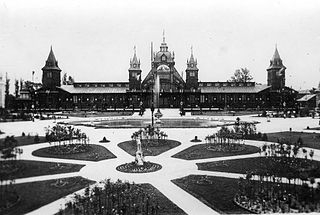
The General National Exhibition in Lviv was a national exposition held in 1894 in the city of Lviv on the centenary of the Kościuszko Uprising. Its aim was to showcase the economic and cultural achievements of Galicia and to present the works of art of the Kingdom of Galicia and Lodomeria as well as all other Polish lands under foreign rule.





















